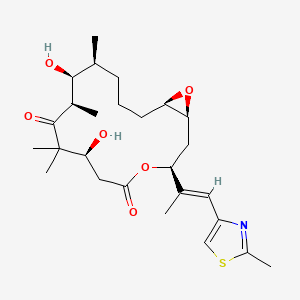| MeSH term | MeSH ID | Detail |
|---|---|---|
| Adenocarcinoma | D000230 | 166 associated lipids |
| Lung Neoplasms | D008175 | 171 associated lipids |
| Neoplasms | D009369 | 13 associated lipids |
Epothilone A
Epothilone a is a lipid of Polyketides (PK) class. Epothilone a is associated with abnormalities such as abnormal fragmented structure and Hyperostosis, Diffuse Idiopathic Skeletal. The involved functions are known as Polymerization, Mutation, Depolymerization, Musculoskeletal torsion, function and Negative Regulation of Microtubule Depolymerization. Epothilone a often locates in Microtubules, soluble, Nuclear Structure and Microtubule cytoskeleton. The associated genes with Epothilone A are C9 gene, SLC33A1 gene, KIF2C gene and HMHA1 gene.
Cross Reference
Introduction
To understand associated biological information of Epothilone A, we collected biological information of abnormalities, associated pathways, cellular/molecular locations, biological functions, related genes/proteins, lipids and common seen animal/experimental models with organized paragraphs from literatures.
What diseases are associated with Epothilone A?
Epothilone A is suspected in and other diseases in descending order of the highest number of associated sentences.
Related references are mostly published in these journals:
| Disease | Cross reference | Weighted score | Related literature |
|---|
Possible diseases from mapped MeSH terms on references
We collected disease MeSH terms mapped to the references associated with Epothilone A
PubChem Associated disorders and diseases
What pathways are associated with Epothilone A
There are no associated biomedical information in the current reference collection.
PubChem Biomolecular Interactions and Pathways
Link to PubChem Biomolecular Interactions and PathwaysWhat cellular locations are associated with Epothilone A?
Visualization in cellular structure
Associated locations are in red color. Not associated locations are in black.
Related references are published most in these journals:
| Location | Cross reference | Weighted score | Related literatures |
|---|
What functions are associated with Epothilone A?
Related references are published most in these journals:
| Function | Cross reference | Weighted score | Related literatures |
|---|
What lipids are associated with Epothilone A?
There are no associated biomedical information in the current reference collection.
What genes are associated with Epothilone A?
Related references are published most in these journals:
| Gene | Cross reference | Weighted score | Related literatures |
|---|
What common seen animal models are associated with Epothilone A?
There are no associated biomedical information in the current reference collection.
NCBI Entrez Crosslinks
All references with Epothilone A
Download all related citations| Authors | Title | Published | Journal | PubMed Link |
|---|---|---|---|---|
| Bollag DM et al. | Epothilones, a new class of microtubule-stabilizing agents with a taxol-like mechanism of action. | 1995 | Cancer Res. | pmid:7757983 |
| Xiao CF et al. | Investigation of inclusion complex of epothilone A with cyclodextrins. | 2014 | Carbohydr Polym | pmid:24507285 |
| Sakaushi S et al. | Differential responses of mitotic spindle pole formation to microtubule-stabilizing agents epothilones A and B at low concentrations. | 2008 | Cell Cycle | pmid:18235240 |
| Jiménez VA et al. | Molecular modeling study on the tubulin-binding modes of epothilone derivatives: Insight into the structural basis for epothilones activity. | 2017 | Chem Biol Drug Des | pmid:28632973 |
| Chen H et al. | Epothilone biosynthesis: assembly of the methylthiazolylcarboxy starter unit on the EpoB subunit. | 2001 | Chem. Biol. | pmid:11564558 |
| Molnár I et al. | The biosynthetic gene cluster for the microtubule-stabilizing agents epothilones A and B from Sorangium cellulosum So ce90. | 2000 | Chem. Biol. | pmid:10662695 |
| Nicolaou KC et al. | Chemical synthesis and biological properties of pyridine epothilones. | 2000 | Chem. Biol. | pmid:11048950 |
| Kingston DG | What makes epothilones stick? | 2004 | Chem. Biol. | pmid:15123274 |
| Finney NS | Enantioselective epoxide hydrolysis: catalysis involving microbes, mammals and metals. | 1998 | Chem. Biol. | pmid:9571210 |
| Cachoux F et al. | Total synthesis and biological assessment of benzimidazole-based analogues of epothilone A: ambivalent effects on cancer cell growth inhibition. | 2006 | Chembiochem | pmid:16345113 |
